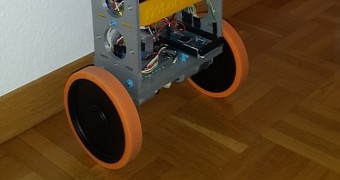You would think that having the electrical parts of a robot on hand would mean that actually building the thing wouldn't take more than a few weekends. This is the mistake that a Switzerland-based man named Paolo Negrini made.
He originally got the idea to construct a robot using the Raspberry Pi credit card-sized miniature personal computer around ten months back.
He thought he would only have to work on it for a few days, spread over several weekends. In the end, he spent almost a year working and redesigning the thing.
Nevertheless, in the end he managed to complete his self-assigned task successfully. The result is the self-balancing robot in the video below, as well as the attached photo.
The Raspberry Pi-driven self-balancing robot
It's really hard to stay balanced on a platform that only has two wheels. Fortunately, the new robot invented by Paolo Negrini doesn't have the wheels set along the same axis.
Still, even with them side by side it's not exactly an easy thing to do, to stand upright the way this as yet unbaptized robot has shown itself capable of.
Negrini first spent a few days learning how to use Openscad computer-aided design software (CAD software for short). Interestingly, Openscad uses text-based instructions instead of mouse-based drag and drop.
He already had some knowledge of the Raspberry Pi and Arduino devices in particular, and electronics in general. 3D printing was also a side hobby for him. Teaching himself Openscad only built on all that.
Eventually, Negrini was able to combine a Raspberry Pi PC, a bunch of sensors (3-axis accelerometer, a barometric pressure sensor, magnetometer, gyroscope), and a 10 Degree of Freedom Inertial Measurement Unit (10DOF IMU, priced at $30 / €23.37) to create the one-eyed robot you see before you. A 350 rpm Pololu 30:1 motor was also part of the picture.
The 3D printing came last, since the chassis of the bot had to be shaped in such a way that everything fit together while not working too badly against the balancing capabilities of the 10DOF IMU. It would have been a shame to waste it, especially since the current tiny price can't compare to the multi-grand tag of several years ago. Negrini himself has been particularly pleased by how cheap it is now.
Future plans
Negrini intends to further develop the robot, like adding a 3D printed sensor module or pan mechanism to the camera, and 3D printing a ballbot balancing on a single ball instead of wheels. You probably won't find any for sale anywhere though.

 14 DAY TRIAL //
14 DAY TRIAL // 